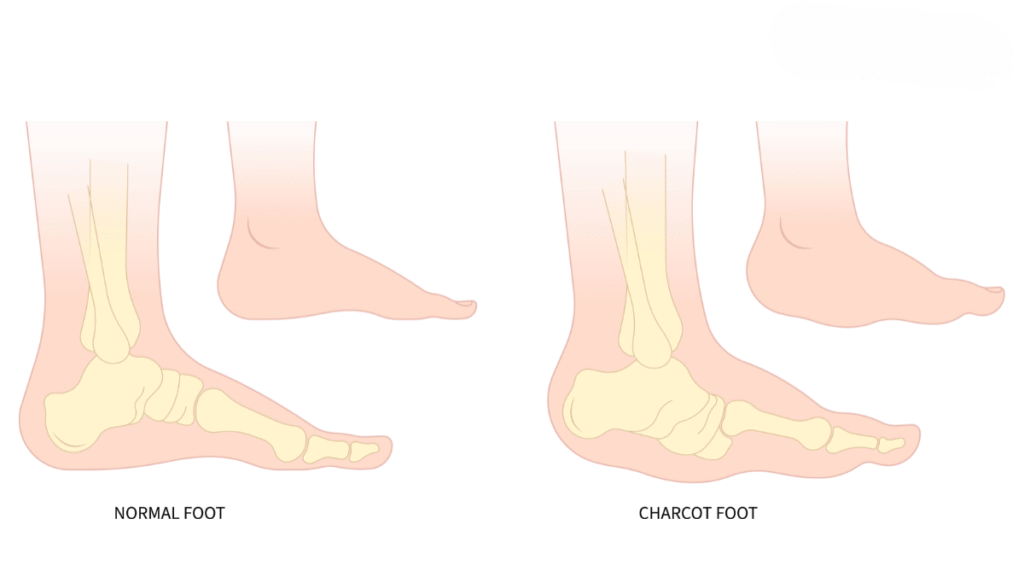The medical world has paid close attention in recent years to the cascade of consequences that can result from uncontrolled diabetes. One of the most crippling—and frequently misdiagnosed—is Charcot’s disease, which subtly alters the foot’s bones and joints, typically without the patient noticing. Diabetic neuropathy, a degenerative type of nerve degeneration that dulls feeling, is the cause of this unsettling quiet.

Charcot’s illness develops almost imperceptibly, starting with inflammation that weakens bones if untreated. Patients continue to walk on damaged feet without realizing they are uncomfortable. This pressure causes joint breakdown and fractures over time. It is remarkable that a patient may experience a midfoot collapse, which completely changes the shape of the foot, without experiencing enough pain to warrant immediate medical treatment.
Charcot’s Disease: Fast Facts Table
| Category | Details |
|---|---|
| Medical Name | Charcot Neuropathic Osteoarthropathy |
| Primary Cause | Diabetes-induced peripheral neuropathy |
| Common Alias | Charcot Foot, Diabetic Charcot Arthropathy |
| Prevalence | Affects less than 1% of diabetics |
| Typical Symptoms | Swelling, warmth, redness, foot deformity |
| Risk Factors | Long-term diabetes, poor blood sugar control, smoking, obesity |
| Complications | Foot deformity, ulcers, infections, amputation |
| Common Diagnostic Tools | X-ray, MRI, physical exam |
| Treatment Focus | Offloading, custom orthotics, surgery if needed |
| Recommended Resource |
“Rocker-bottom” feet are among the most cosmetically concerning results. The midfoot falls downward, producing a rounded bulge in place of the natural arch. It’s not just a cosmetic adjustment. It seriously impairs stability, making even everyday walking dangerous. Additionally, these abnormalities cause pressure to be transferred to unexpected places, which raises the risk of infections and ulcers.
Internal harm is frequently already present by the time such outward symptoms appear. Imaging tests, particularly MRIs, are essential for early detection because they can reveal bone fragmentation and marrow edema. Despite the tranquil surface, these scans show a disorder that is rapidly demolishing the foot from within.
Many patients postponed regular foot care visits throughout the outbreak. Because of this, physicians have observed a rise in late-stage Charcot diagnoses, in which the deformity has already progressed. This concerning trend illustrates how minor issues might become unmanageable due to gaps in preventive care.
The best course of action, unloading, is quite comparable to casting a fractured leg from a therapeutic perspective. Patients usually use wheelchairs, walkers, or detachable boots to prevent placing any weight on the injured foot. The damaging loop is effectively stopped by this immobility. In many cases, bone remodeling slows, the inflammation goes down, and the need for surgery decreases.
Surgery continues to be a particularly creative treatment for people with severe abnormalities. In order to restore alignment and stop more deterioration, surgeons use plates or screws to stabilize the internal architecture of the foot. However, there are hazards associated with these operations, particularly for individuals who have poor circulation or wound healing.
Podiatrists and endocrinologists have started advocating for more integrated care approaches through strategic partnership. This method significantly enhances results by integrating orthopaedic therapies with diabetes control. These partnerships represent a new era of interdisciplinary care, particularly for disorders like Charcot’s that cut across the fields of neurology, endocrinology, and orthopedics. They are not just symbolic.
Increasing knowledge of Charcot’s disease could greatly lower the number of late diagnoses in the context of public health. It serves as a warning that harm can persist and be severe even in situations where there is no pain. Regular foot examinations should be regarded as a type of necessary maintenance, similar to inspecting your car’s brakes before a lengthy drive, especially for diabetics with neuropathy.
Celebrities who have diabetes have encouraged people to be aware of potential consequences by using their platforms. Actor Nick Jonas, for example, has frequently underlined the significance of strict glucose management and self-monitoring despite not having Charcot’s disease. His activism is especially helpful in bringing attention to the invisible harm that high blood sugar can cause and in de-stigmatizing complications.
The illness is now a driving force behind innovation for medtech businesses in their early stages. There are now commercially accessible insole sensors that track temperature variations and pressure distribution. These gadgets are quite flexible and provide doctors and patients with real-time input. The program may also notify users when patterns point to inflammation, a crucial indicator of Charcot activity, thanks to the integration of AI.
Early intervention rates have significantly increased with the introduction of these technologies, providing patients with a much-needed advantage in preventing malformations. When compared to the expense of surgery or permanent impairment, these improvements are remarkably inexpensive.
Telemedicine is probably going to be a key component of Charcot foot treatment in the years to come. Providers can monitor high-risk patients more frequently without having to deal with the inconvenience of clinic visits by utilizing remote diagnostics. This change not only improves care but also gives patients more control over their own healing.
